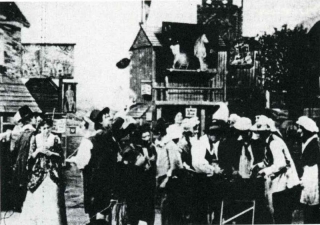Ken Jacobs Retrospective: 2
Date: 14 October 2000 | Season: Ken Jacobs Nervous System, Leeds Film Festival 2000
KEN JACOBS RETROSPECTIVE: PROGRAMME 2
Leeds International Film Festival
Saturday 14 October 2000, at 12:30pm
TOM, TOM THE PIPER’S SON
Ken Jacobs, USA, 1969-71, 16mm, 18fps, silent, b/w, & colour, 115 min
Cinematography assistant, Jordan Meyers. Negative matching assistant, Judy Dauterman. Florence Jacobs super-assisting throughout.
We had to work at night because of our skylight, but when Jordan wasn’t asleep at his feet at the Victor, projecting at the rear screen over Flo-in-bed, his eyes were open. Thank you again, Judy, for perseverance and loving good humour, and for encouraging and helping with the addition of the sliding film section.
Original 1905 film shot and probably directed by G.W. “Billy” Bitzer (and returned from limbo, rescued via Kemp Niver refilming a deteriorated paper print filed for copyright purposes with the Library of Congress.) It is most reverently examined here, with a new movie almost incidentally coming into being.
Ghosts ! Cine-recordings of the vivacious doings of persons long dead. The preservation of their memory ceases at the edges of the frame (a 1905 hand happened to stick into the frame … it’s preserved, recorded in a spray of emulsion grains). One face passes ‘behind’ another on the two-dimensional screen.
The staging and cutting is pre-Griffith. Seven infinitely complex cine-tapestries comprise the original film, and the style is not primitive, not un-cinematic, but an inspired indication of another, alternate path of cinematic development, its values only recently rediscovered. My camera closes in only to better ascertain the infinite richness (playing with fate, taking advantage of the loop-character of all movies, recalling and varying some visual complexes again and again for particular savouring), searching out incongruities in the story-telling (a person, confused, suddenly looks out of an actor’s face), delighting in the whole bizarre human phenomena of story-telling itself and this within the fantasy of reading any bygone time out of the visual crudities of film: dream within a dream!
And then I wanted to show the actual present of the film, just begin to indicate its energy. A train of images passes like enough and different enough to imply to the mind that its eyes are seeing an arm lift, or a door close; I wanted to “bring to the surface” that multi-rhythmic collision-contesting of dark and light two-dimensional force-areas struggling edge to edge for identity of shape … to get into the amoebic grain pattern itself – a chemical dispersion pattern unique to each frame, each cold still … stirred to life by a successive 16-24 f.p.s. pattering on our retinas, the teeming energies elicited (the grains ! the brains !) then collaborating, unknowingly and ironically, to create the always-poignant-because-always-past illusion.
(Ken Jacobs, statement in “Films That Tell Time: A Ken Jacobs Retrospective”, American Museum of the Moving Image, 1989)
“Anamnesis is a technical term referring to the recovery of anxiety-provoking incidents, a process that appropriately describes Jacobs’s extensive record of reworking of found footage. It begins in 1955 with the purchase of an analytical projector capable of variable speed projection in both forward and reverse. Evenings spent “toying” with this device, exploring the ‘inner workings” of the movie image culminated in the production of Tom, Tom the Piper’s Son (1969-71), a two-hour visual exegesis of a ten-minute 1905 Biograph Company film shot by Billy Bitzer. Still his best-known work, Tom, Tom became critically ensconced as an avatar of the minimalist trend in avant-garde cinema dubbed Structural Film, a label Jacobs vehemently rejects. His object, as it were, was not a dry demonstration of mechanical properties of the medium but a magical raising of the dead: “Ghosts! Cine-recordings of the vivacious doings of persons long dead.” Refilming the Billy Bitzer tableaux, pictorially modelled after Hogarth, Jacobs slows down and isolates individual figures, capturing their casual distractions, their sensual movements and metaphoric encounters with other actors or props. He freeze-frames, reverses the motion, delves into ostensibly blank portions of painted backdrops.
“The humorous market day fable of the original is transformed into a truly carnivalesque parade of outlandish poses melting into authentic gestures of pleasure and vice versa, a hide-and-seek game of narrative role-playing ballasted by abstract shapes and balletic repetitions. As a side dish to Jacobs’s swelling feast, the art-historically inclined viewer is treated to a successive evocation of compositional styles, a selective review of modern painting that runs from Goya to the Impressionists and Seurat to Abstract Expressionists such as Franz Kline. Hidden archaeological details of the original are played against the constant recognition of moment-to-moment processes of refilming: flares, the foregrounded projector bulb, the placement of the translucent screen and, in a sequence shot in colour, a plant decorating the filmmaker’s loft. The ebb and flow of temporal strata is matched by the play of flatness and illusionistic depth.”
(Paul Arthur, excerpted from “Creating Spectacle From Dross: The Chimeric Cinema of Ken Jacobs”, first published in American Cinematographer magazine, 1997)
Also Screening:
Thursday 7 December 2000, at 7pm, London Lux Centre
